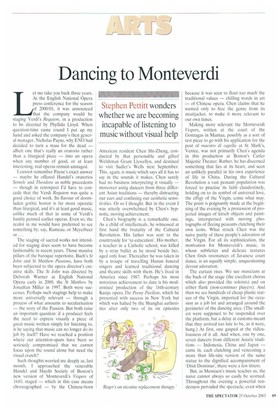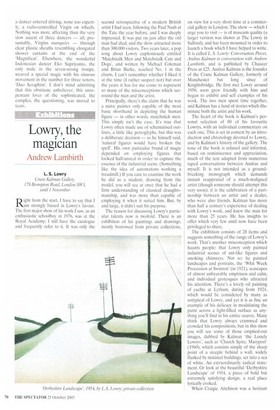Dancing to Monteverdi
Stephen Pettitt wonders whether we are becoming incapable of listening to music without visual help
LtLAet me take you back three years. At the English National Opera conference for the season f 2000101, it was announced that the company would be staging Verdi's Requiem, in a production to be directed by Phyllida Lloyd. When question-time came round I put up my hand and asked the company's then general manager. Nicholas Payne, why ENO had decided to turn a mass for the dead — albeit one that's really an oratorio rather than a liturgical piece — into an opera when any number of good, or at least interesting, real operas remain uristaged.
I cannot remember Payne's exact answer — maybe he offered Handel's oratorios Semele and Theodora as noble precedents — though in retrospect I'd have to concede that the Verdi Requiem was quite a good choice of work. Its flavour of doomladen gothic horror is far more operatic than liturgical, and it's at least good music, unlike much of that in some of Verdi's hastily penned earlier operas. Even so, the zealot in me would have preferred to see something by, say, Rameau, or Meyerbeer or . ..
The staging of sacred works not intended for staging does seem to have become fashionable in recent years. Those massive pillars of the baroque repertoire, Bach's St John and St Matthew Passions, have both been subjected to the opera director's creative skills. The St John was directed by Deborah Warner at English National Opera early in 2000. the St Matthew by Jonathan Miller in 1997. Both were successes. Perhaps such stagings help to make more universally relevant — through a process of what amounts to secularisation — the story of the Passion. But both raise an important question: if a producer feels the need to express visually a piece of great music written simply for listening to, is he saying that music can no longer do its job by itself? Have we reached a position where our attention-spans have been so seriously compromised that we cannot focus upon the sound alone but need the visual crutch?
Such thoughts worried me deeply as, last month, I approached the venerable Handel and Haydn Society of Boston's new version of Monteverdi's Vespers of 1610, staged — which in this case means choreographed — by the Chinese-born American resident Chen Shi-Zheng, conducted by that personable and gifted Welshman Grant Llewellyn, and destined to visit Sadler's Wells next September. This, again, is music which says all it has to say in the sounds it makes. Chen surely had no business interpreting it visually — moreover using dancers from three different Asian traditions — thereby distracting our ears and confusing our aesthetic sensitivities. Or so I thought. But in the event 1 was utterly overwhelmed by Chen's hypnotic, moving achievement.
Chen's biography is a remarkable one. As a child of intellectuals, he witnessed at first hand the brutality of the Cultural Revolution. His father was sent to the countryside for 're-education'. His mother, a teacher in a Catholic school, was killed by a stray bullet as he stood beside her, aged only four. Thereafter he was taken in by a troupe of travelling Hunan funeral singers and learned traditional dancing and theatre skills with them. He's lived in America since 1987. Perhaps his most notorious achievement to date is his modernised production of the 16th-century Kunju opera The Peony Pavilion, which he presented with success in New York but which was halted by the Shanghai authorities after only two of its six episodes because it was seen to flout too much the traditional values — chilling words in art — of Chinese opera. Chen claims that he wanted only to free the genre from its straitjacket, to make it more relevant to our own times.
Making more relevant the Monteverdi Vespers, written at the court of the Gonzagas in Mantua, possibly as a sort of test piece to go with his application for the post of maestro di capella at St Mark's, Venice, was not primarily Chen's agenda in this production at Boston's Cutler Majestic Theater. Rather, he has discerned something that lies at its heart, and seen an unlikely parallel in his own experience of life in China. During the Cultural Revolution a vast peasant population was forced to practise its faith clandestinely, holding on to its symbol of universal love, the effigy of the Virgin, come what may. The point is poignantly made at the beginning of the evening by a procession of projected images of kitsch objects and paintings, interspersed with moving photographs of fleeing peasants clutching their own icons. What struck Chen was the naive purity of these people's adoration of the Virgin. For all its sophistication, the motivation for Monteverdi's music, in whose subtleties and delicate textures Chen finds resonances of Javanese court dance, is an equally simple, unquestioning devout adoration.
The curtain rises. We see musicians at the back of the stage (the excellent chorus which also provided the soloists) and on either flank (non-continuo players). And then we see hundreds of cheap plastic statues of the Virgin, imported for the occasion as a job lot and arranged around the perimeter of the dancing area. (The smallest were supposed to be suspended over the platform, but a delay at customs meant that they arrived too late to be, as it were, hung.) At first, one gasped at the ridiculousness of it all. And when, one by one, seven dancers from different Asiatic traditions — Indonesia, China and Japan — came in, each clutching and venerating a more than life-size version of the same statue to the dignified accompaniment of `Dixit Dominus', there were a few titters.
But, as Messiaen's music teaches us, the naive cannot always so easily be scorned. Throughout the evening a powerful tenderness pervaded the spectacle, even when a dancer entered driving, none too expertly, a radio-controlled Virgin on wheels. Nothing was more affecting than the very slow ascent of three dancers — all, presumably, Virgins manquees — through clear plastic sheaths resembling elongated shower curtains at the end of the `Magnificat". Elsewhere, the wonderful Indonesian dancer Eko Supriyanto, the only male in the seven-strong troupe, weaved a special magic with his sinuous movement in the number for three tenors, Duo Seraphim'. I don't mind admitting that this obstinate unbeliever, this unrepentant lover of the sophisticated, the complex, the questioning, was moved to tears.



































































































 Previous page
Previous page